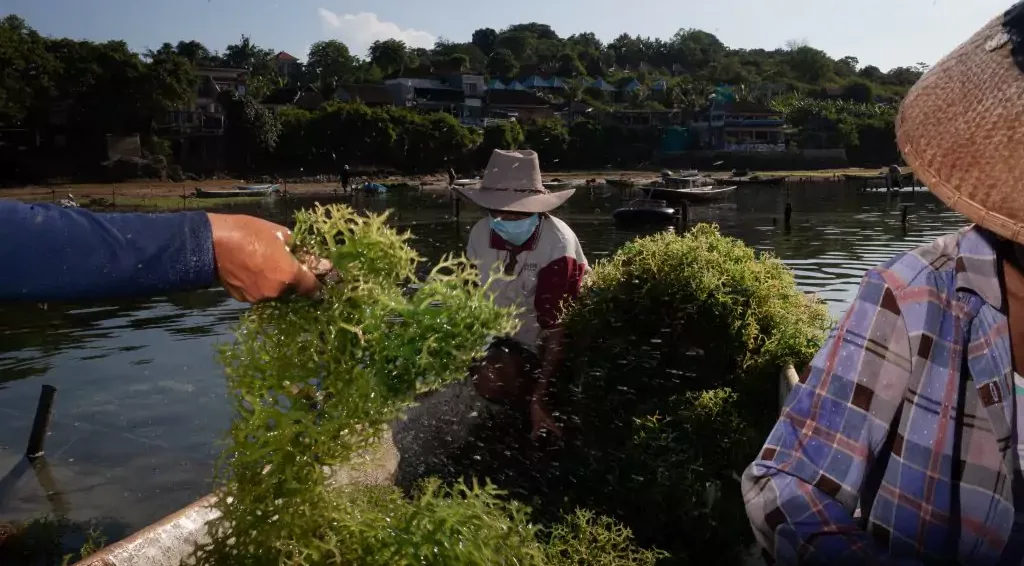
Since the Covid-19 pandemic started, Nusa Lembongan has not been as busy as before, just like other places. However, there is something different in Nusa Lembongan.
On normal days, the road is filled with vehicles and people running around. Most of them are tourists, foreigners and local residents. The cafe is always full. Meanwhile, the only part of the island that is quiet is the beach facing Nusa Ceningan. You will probably only see a few seaweed farmers around the beach. Now things have turned 180 degrees. The Cafe closed. Motorbike rentals are exposed to dust.
In contrast to during the pandemic, the beaches are busy. We can see seaweed cultivation plots that stretch to Nusa Ceningan Island. All island residents are now seaweed farmers. People who work in laundry, spa, car and motorbike rental businesses and hotels are currently working in seaweed cultivation. The tide was rising that morning when an old woman walked slowly towards the road from the sea. His grandson was waiting for him on his motorbike, ready to go. Ni Wayan Uri – the grandmother, sits on a chair and goes home with her grandson. Ni Wayan Uri – familiarly known as Meme, is 70 years old but is still in top condition. For the past year, Meme has been working in seaweed cultivation and is responsible for attaching seaweed to ropes. In a day, he can complete around 20-30 ropes and is paid IDR 1,000 for each rope from his neighbor, the owner of a seaweed farm. Meme doesn’t work on a seaweed farm every day; he only works on orders.
When the tourism industry emerged on Nusa Lembongan in the early 1990s, people slowly shifted their livelihoods from seaweed cultivation. Many of the island’s senior citizens feel sad that no one hires them to tie seaweed. Again. Meanwhile, that’s the only job worth doing for seniors.
Meme and her husband, Wayan Surat, live in the same neighborhood as their son and his family. This is a common thing in Bali where parents live independently but remain close to their children. His parents lived in a smaller house while his son lived in a larger house nearby. Wayan Surat is now an 81-year-old grandfather who has lost his sight.
Meme lost her mother at birth and was raised by her stepmother. In her youth, Meme worked in the fields, growing corn, sweet potatoes, bananas and beans. Now Meme and her husband can no longer work in the fields. Apart from losing their eyesight, they have also rented their land to several entrepreneurs for 15 years. Initially the tenant wanted to build various tourism facilities. But nothing has happened, except for the land being eroded by the waves. Meme also sells canang (a daily offering of Balinese Hindus) as additional income. Canang is the simplest Balinese Hindu offering, made from coconut tree leaves, and filled with colorful flowers, incense, and other small ingredients. In the past, adult women had to be able to make canang. But nowadays, people prefer to buy it. The basic price of canang is IDR 3K, and is supplemented by further requests, such as additional cigarettes, tobacco, lime, areca nut and betel leaves; the price is IDR 5K. People can also order dishes offered by God Bharata from Meme which include oranges, bananas, dadap leaves, ylang ylang, pandan and various typical Balinese snacks.
In 1989, Meme and her husband tried to cultivate seaweed in 1989 with six plots. However, this business began to decline in 1999 when the tourism sector developed rapidly. Their seaweed cultivation stopped in 2004. That’s when Meme started making canang and pandan mats to sell. Currently, it is difficult to get pandan leaves in Nusa Lembongan.
In 2019, seaweed cultivation slowly began to reappear on Nusa Lembongan. Meme returns to work as a laborer on a seaweed farm. At that time, Meme helped Suarbawa – a pioneer in seaweed cultivation on the island, who was also a field officer for an organization called Kalimanjari. Meme is involved in the seaweed strain purification program funded by GEF-SGP Phase VI.
We can see some people on the horizon. They are seaweed workers, both harvesting and installing seaweed ropes. Nusa Lembongan experienced a golden age for seaweed in the 80s and 90s, when many local residents paid for their children to graduate from university, thanks to Nusa Lembongan’s seaweed cultivation. Based on this history, the people of Nusa Lembongan believe that this pandemic is God’s way of reminding them of seaweed. Back to nature. Now, Meme and dozens of other Lembongan elders can smile again. Seaweed has once again become part of the economic life of the people of Nusa Lembongan.
Author: Ery Damayanti and Harijanto Suwarno
Photographer: Edy Susanto
GEF SGP Indonesia supports the Nusa Lembongan Seaweed project
https://www.undp.org/indonesia/blog/seaweed-made-its-way-back-home

